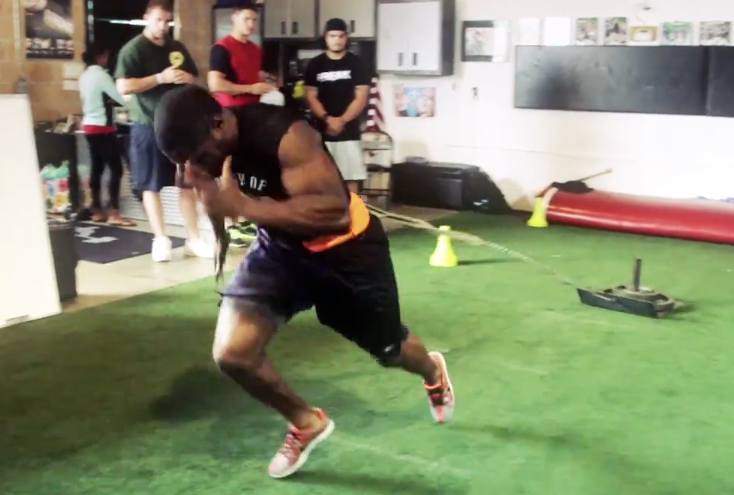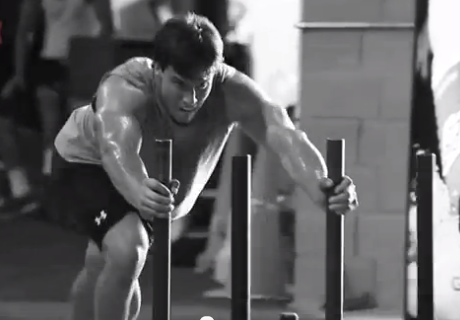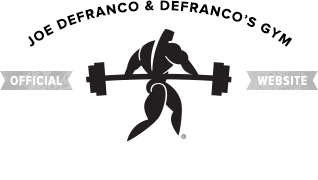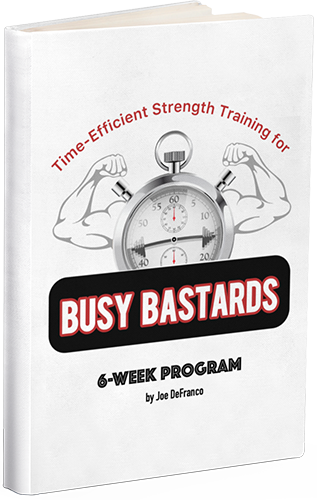
Q: Joe D –
Huge fan of your work. I’m currently saving up enough $ to come train at your gym next summer and hopefully learn from you firsthand. I had a question about sprinting with a weight sled and pushing a heavy prowler. I’ve done some research and it seems many sprint coaches have strong opinions about resisted sprints. It seems most coaches preach to only use a weight that represents 10% or less of the athletes BW on the sled, anything heavier will alter mechanics and also prevent the athlete from moving fast enough to develope speed. I’ve seen many youtube videos of your guys pushing heavy sleds so I’d love your input coach. If you dont have time to answer this i totally understand. hope to see you in 2013!!!
Josh
A: Josh,
Great question. This is one of those topics that coaches will argue and debate to the point where fist fights almost break out! Truthfully, I really don’t understand why it’s such a controversial topic. It’s not that complicated when you think about it.
Here’s my input…
First of all, the “10% rule” originated from track coaches who were referring to resisted sprints for their sprinters. Training a sprinter is an entirely different animal compared to all other athletes. Perfecting linear sprint mechanics is the sport of a sprinter – so the “10% rule” makes sense for them. They must be extremely careful NOT to alter their running mechanics and engrave improper motor patterns during their training. The slightest alteration in their posture, arm swing, etc., can negatively effect their sprint time. Because of this, the “10% rule” is definitely something they should respect when sprinting with resistance.
On the other hand, how often do athletes from other sports run perfectly in a straight line during competition?
Here are some examples of non-track athletes:
–A football lineman’s job is to basically take one step before he runs into heavy “resistance” (another player) and slap fights him or tries to drive him into the ground…
–A football running back has to run with a ball in his hand while cutting side to side, jumping and dragging defenders as they try to take his head off…
–Soccer players must be able to run while simultaneously kicking a ball and constantly changing direction…
–Tennis players hold a racket in their hand the entire match, so their sprint mechanics are far from perfect…
–Wrestlers need speed/power to execute explosive takedowns, yet perfect “sprint mechanics” are definitely not a requirement for the sport…
I can continue with examples of baseball, hockey, basketball, volleyball and just about every other sport, but I think you get my point.
The bottom line is that most athletes rarely run in a straight line without any “distress” during competition. Because of this, “non-track” athletes do NOT always need to live by the “10% rule” when performing resisted sprints. They can definitely benefit from pushing or sprinting with heavier loads, even if it slightly alters their sprint mechanics.

This brings me to my final point…
I want to make it clear that sled work is strength work when used in this manner. Even though you’re running with the sled and/or running as you push the prowler; it should be classified as strength work in your programming (due to the load and speed of movement). Don’t get me wrong; this form of “strength training” can definitely improve sprinting speed in and of itself (depending on the level of the athlete). But, this does NOT mean it should replace speed training! They are two completely different aspects of training. If/How you incorporate these heavier sprints/pushes into your programming depends entirely on your individual strengths, weaknesses, goals, etc. (NOTE: “Heavier” sled sprints should be performed for short distances. I recommend 5-20 yards, depending on the athlete’s sport, position, goals, etc.)
Hope this answer helped clear things up for you.
For those of you who found this blog post interesting; you’re going to LOVE our upcoming dvd – SPEED! This dvd is going to be one-of-a-kind as it will focus on the speed training aspect of programming for non-track athletes. It will be available before the holiday season, so make sure you have it at the top of your Christmas list 🙂
-Joe D.
P.S. Our 1st Certification course SOLD OUT in one day! In order to accomodate the high demand, we’ve added 2 more course dates. These are the last 2 courses of 2012. TAKE ACTION by clicking HERE –> Certified Physical Preparation Specialist (CPPS)






Hello,
This is Harris from Grace Grass.
We found that your company was professional used of the heavy training sled.
Now we have the grass want to recommend to you.
Our grass is specifically used in the heavy training sled.
It can effectively reduce the friction generated when used.
Hope we will start a long-term and friendly cooperation!
If you have interest in this grass, plz contact me by e-mail, let’s talk details
I’m glad to help you to solve all the problems you meet.
Have a good day!
Best wishes,
Harris
Changzhou Grace Grass Co.,Ltd
Tel:+86 13606111989
wechat:mmm139765
skype:3328972861@qq.com
Thanks for making it clear that working with sleds is strength work and not simply speed/agility training. I used to see things backward myself with football blocking sleds, but then we got an a power driver indoor football sled which started to alter my perspective. I like that thing because it’s strength training, but still has technique meshed in to the workout.